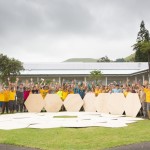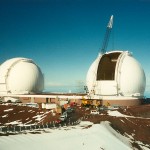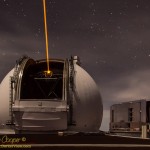W. M. Keck Observatory press release…
Twenty-five years ago in 1990, the average US house cost $123,000, the Dow Jones averaged 2633 and gasoline cost a little more than a dollar-thirty a gallon. Saturn wasn’t just a planet: it was now a newly launched car company from GM, The Simpsons was aired for the first time and the Space Shuttle Discovery placed the Hubble Space Telescope into orbit.

Want Of Light
Before the W. M. Keck Observatory was built, the 200-inch Hale Telescope at Palomar Observatory reigned supreme. It was the largest telescope in the world, but after 50 years, progress in astronomy was flattening out because the instruments needed more photons than the 5-meter mirror could provide.
The biggest hindrance to an explosion of discoveries was a want of light and the telescopes themselves were the problem. Mirrors larger than Palomar’s could not be made and supported at the exacting levels needed for astronomy.
Challenge in hand, a few bold engineers dared to draw up the first sketches of a radical new approach to gathering light: tile together smaller hexagons, and control them so finely that they would act as a single, giant mirror. After countless iterations and debates, Jerry Nelson – who would become the principal designer of the Keck Observatory telescopes – convinced the University of California (UC), which was thinking of building a 7-meter telescope, to allow him and Terry Mast of the Lawrence Berkeley National Laboratory (LBNL) to develop a 36-segment design that would increase humankind’s ability to collect light by a factor of four.
The strong support of the leadership at LBNL and at UC was essential in providing early funding needed for development of Nelson’s ideas. “Thanks to these institutions, we actually had all the money we asked for, so work progressed limited only by our ability to recognize and solve technical problems,” Nelson said. And that design work led to the equally important support and enthusiasm of the California Institute of Technology (Caltech), which convinced Howard Keck, a trustee of the W. M. Keck Foundation, to rally support for the project with $70 million to build Keck I, then another $68 million to build Keck II.
Hawaii was selected for the site after UC undertook a comprehensive test program and confirmed the excellent site properties of Maunakea, according to Gerald (Jerry) Smith, Big Island resident and the Keck Observatory project manager. The only other competitive sites in the world were in Chile and, at the time, no serious consideration was given to locating the observatory there. In addition to having the best seeing conditions on Earth, Maunakea also had the advantage that it provided relatively easy access from the West Coast.
Although this wasn’t Smith’s first telescope, there were some definite firsts that had to be navigated.
“One thing we missed at first was the mirror,” Smith said. “There were a lot of surprises in making the mirror.” Specifically, the shape of the segments made them too difficult to polish after being cut. “The degree of difficulty was higher than we thought,” he said. “We knew the material would bend a little bit and we believed the contractor had the capability to polish out right to the edge.”

“Even with that, we had a little serendipity there called ‘ion figuring’ – it shoots a beam of ions and erodes the glass, which allows you to polish very small areas,” Smith said. “It was being developed at Kodak during the same time we were running into problems with the warping. It basically solved our issues,” he said.
With the segments in order, the team got the big issue of getting all the pieces to work together in every position the mirror would point. Gravity affects each segment differently depending on its position, and a complex mechanical and software system was developed to enforce a single, parabolic shape to all 36 segments.
“When we first got the telescope built with just nine segments, that was the first time we knew it was going to work,” Smith said. “We got nine segments all under computer control as it was designed. And we got an image. That was really the moment of success that we knew we had this and we were going to finish it and have a great telescope.”
Nine segments also reproduced the size of the Palomar mirror, perhaps not coincidentally. And on the evening of November 24, 1990, those nine segments were used to take the first image of spiral galaxy NG1232.
The lean and mean mentality developed during construction became a permanent part of the culture at the Keck Observatory. That drive allowed great science to happen, but made for some tough working conditions.
“When we first became operational at Keck I, we had a staff of about 40 people, which is about one-third of the staff we have now,” said Hilton Lewis, Director of W. M. Keck Observatory who was hired in 1986 to help develop the software that operates the telescopes. “It was very intense in the early days; you’d work all day, go home, sit down for dinner and that’s when the phone would start ringing, because that’s when the evening crew would show up. You’d be on the phone for several hours in the early part of the nights, and then go to bed. Then the phone would ring several times between then and dawn and then you’d come back in for the next day. When you are a very tightly knit group and everyone is depending on everyone else, you do what you need to do.”
While the work was hard, it was also rewarding.
“It was very exciting,” Lewis said. “We were doing stuff that no one in the world was doing. Even though we weren’t working nearly as efficiently as we are nowadays, we were still doing remarkable science. All that early science was done on the backs of a tiny number of people. Back then every problem was new. When a problem came up you had to try and solve it in real time – the astronomers were very anxious to get going. By comparison, now it’s a really smooth-running machine,” he said.

Enter the Golden Age
From brilliant design, sheer grit, and less than 6 percent of what the Hubble Space Telescope cost, the W. M. Keck Observatory was born and has since remained home to the two biggest and most scientifically productive telescopes on Earth.
Although the huge light-gathering power of the two 10-meter primary mirrors was central to the observatory’s success, its location on Maunakea, with its spectacularly dark skies and stable air, as well as the observatory’s world-leading instruments.
All that put together meant that Keck could do observations that were considered completely impossible at other observatories. There were immediately a bunch of problems in astronomy that were being addressed by Keck Observatory that were impossible to address anywhere else.
That enormous pent up demand for answers set Keck Observatory’s role from day one: Astronomers used the telescopes to glean answers to hypotheses formed from other observations. Twenty years ago there were a number of big questions about the Universe were just that: questions.
For example, in 1990, we didn’t even know if there were planets outside of our own solar system. Since 1992, thousands of planets have been discovered. In 2008, a team at Keck Observatory were the first to directly image planets orbiting another star and in 2013, scientists using Keck Observatory statistically determined that twenty percent of Sun-like stars in our galaxy have Earth-sized planets that could host life.
Other major revelations in astronomy from Keck Observatory include:
Proving the Existence of the Milky Way’s Supermassive Black Hole;
Observing the most distant (youngest) galaxies in the Universe; and
The discovery of dark energy and the accelerating expansion of the Universe
And much remains to be discovered. “Basically there are as many unanswered questions now as ever,” Lewis said. “If anything, the mysteries are deeper. Each layer we pull back reveals more complexity.”
Madly Creative
While the Keck Telescopes gather more light, have the best instruments, and are hosted by the best site in the world, the real X Factor comes from the astronomers whose creativity constantly pushes the limits of what is possible.
“A crucial part of the observatory’s success comes from the way the community has come together to use it,” Lewis said. “Their clamor to use Keck Observatory because we have the biggest telescopes in the world and have this enormous light grasp and fantastic instrumentation has attracted a class of astronomers that are incredibly motivated and very talented.
“It’s a Darwinian/entrepreneurial process; someone starts out with a little idea, and they push it and try and take advantage of capabilities we have at Keck,” Lewis said. “It’s a virtuous circle of success. The observers discover something that no one has seen before and so they get more time on the telescope. As they get more information, we take that into account in our strategic plan as we design new instruments. The ambitious and visionary scientist is a big part of pushing us forward.”

Science Guaranteed
Oversubscribed by up to a factor of six, Keck Observatory’s role has often been the endgame for many of the most important projects in astrophysics, with only the most impactful proposals being granted coveted time on each of the mighty Kecks.
Perhaps the greatest testament to Keck Observatory’s amazing engineering and operational achievements is it has become the model from which future telescopes are being built. The James Webb Space Telescope, the Thirty Meter and the European Extremely Large Telescopes are built using the architecture developed and perfected by Keck Observatory.
Astro Moxie
Perhaps the most powerful forces moving Keck Observatory forward into the future are the funding visionaries: the people at NASA who decided to be a partner in Keck; the university officials who decided to invest in astronomy; the philanthropists who put their resources in Keck to push forward the frontiers of science; and the federal funding agencies that continue to invest in Keck’s capabilities.
Today, the economic climate has changed from 1990. With some observatories being shuttered from lack of funding, private philanthropy is becoming increasingly important.
That’s an advantage that Keck Observatory has ingrained it its DNA.
In fact, Keck I was the only large telescope built entirely from private funds.
“The Keck Foundation funding was one of the largest private grants ever made,” said Jerry Smith. “With that level of support, we could get what we needed and go on a fast track.”
The past 25 years have continued to be extraordinary. Hundreds of people in Hawaii from myriad backgrounds have dared to dream the impossible and demanded that realization.

